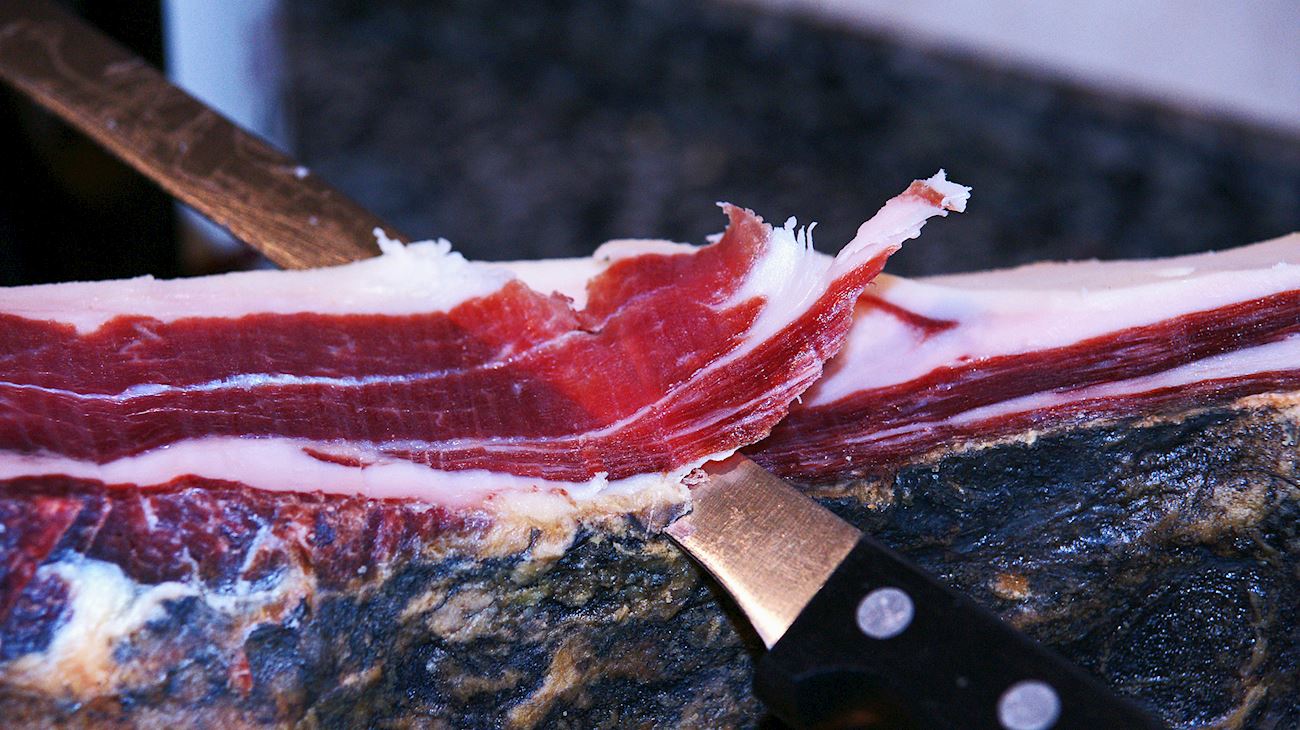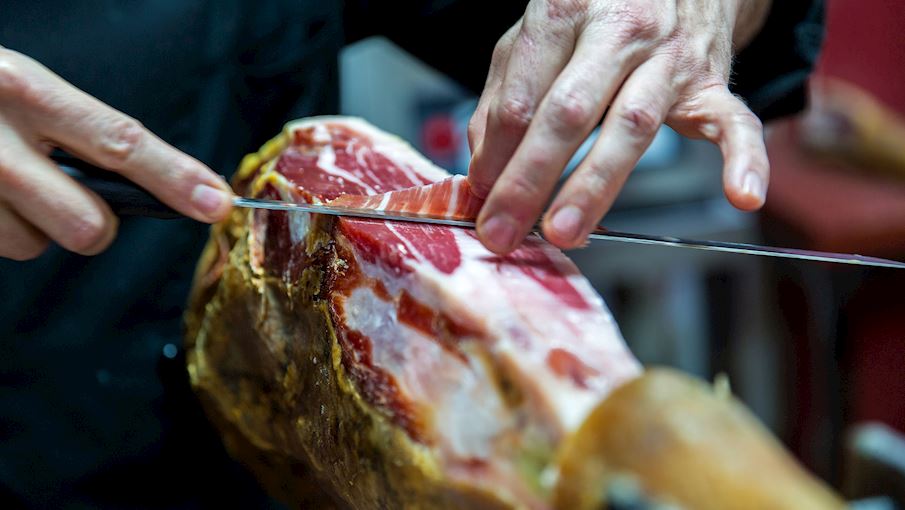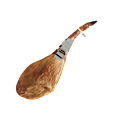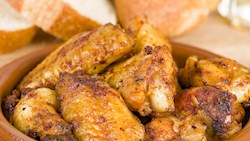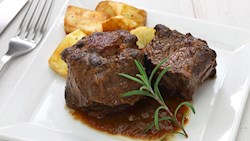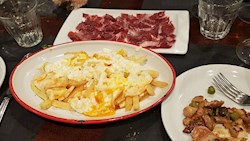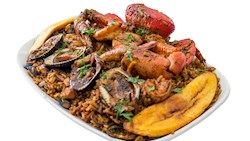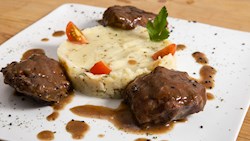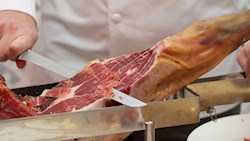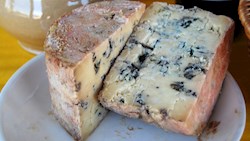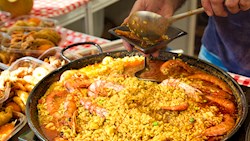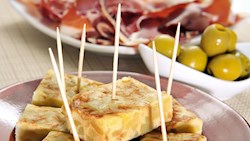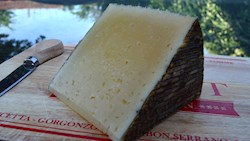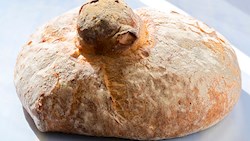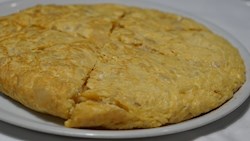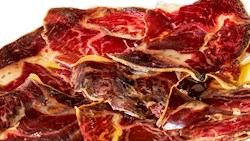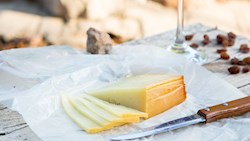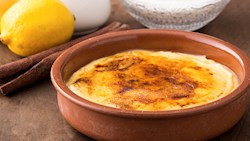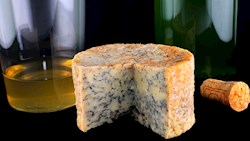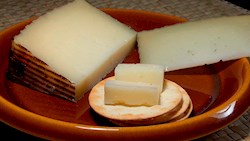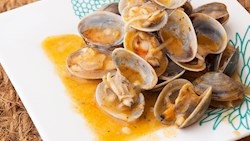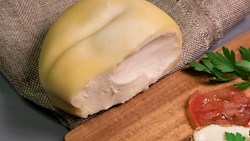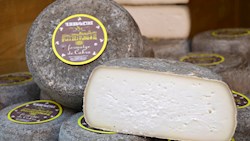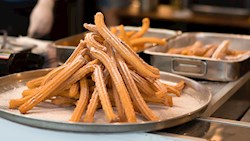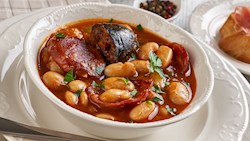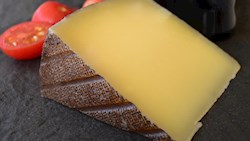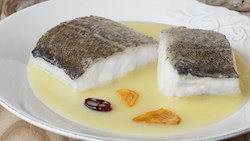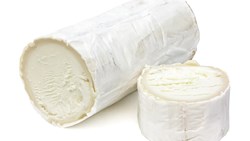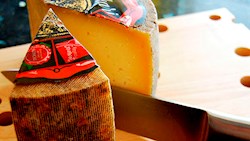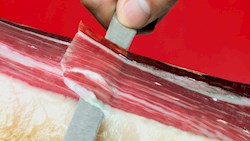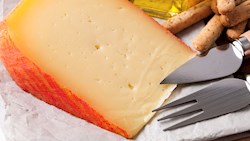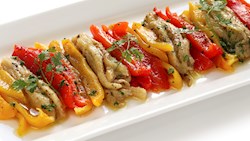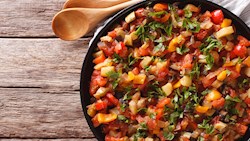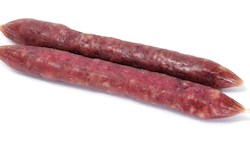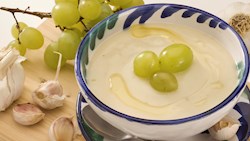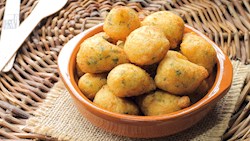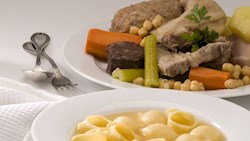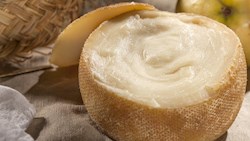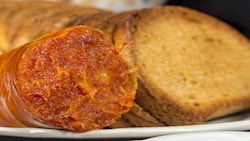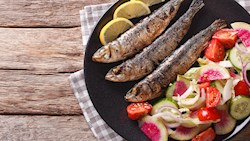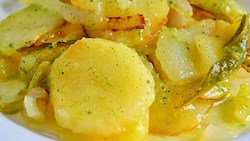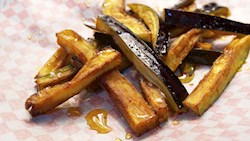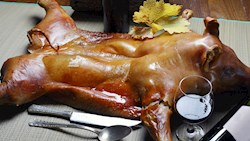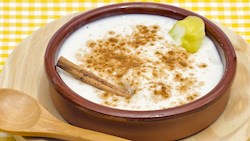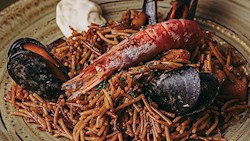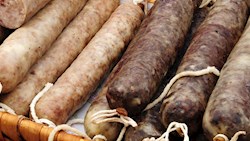TABLE OF CONTENTS
Best Spanish Foods
This variety of Iberian ham is produced with meat coming from acorn-fed Iberian pigs that are either 75% or 50% pure Iberian breed, meaning they have been crossbred with other pigs such as the Duroc breed. As in the case of jamón 100% ibérico de bellota, the pigs used in the production of this ham are allowed to roam freely across the oak pasturelands in their final rearing stage, known as the montanera, eating an acorn-based diet until they reach the desired weight for the sacrifice, or the matanza as the Spanish call it. Jamón ibérico de bellota makes for about 13% of the total Iberian ham production and is distinguished by a red label.
The designated areas of Iberian bellota ham production include the Dehesa de Extremadura, Salamanca, Huelva, and Valle de Los Pedroches in Spain, along with Barrancos in Portugal.
OTHER VARIATIONS OF Jamón Ibérico
Lomo bellota ibérico 100% is a traditional pork loin. This type of pork loin is the most prized of them all because it's made from pure Iberian pigs. The flavor is the most intense of all the varieties and it has the most homogenous fat infiltration.
Due to the small size of 100% Iberian pigs, lomo bellota ibérico 100% is usually shorter and narrower as well. When served, lomo is traditionally sliced thin and accompanied by breads, drizzled with olive oil, or wrapped around other foods such as cheese or fruit.
Jamón Serrano is a cured ham produced using the traditional methods dating back to Roman times. This ham has a bright pink to purple color and shiny appearance when cut. This ham is made in four separate steps that include salting, washing, post-salting, and drying or maturation.
Jamón Serrano is cured and dried without skin for more than a year and has a delicate and characteristic aroma. Not much salt is used during the production of this emblematic ham, which makes it only slightly salty and brings out sweet notes that complement the flavor beautifully.
Vieiras en su concha is a traditional dish originating from Galicia, consisting of scallops served in their shells. The dish is usually made with a combination of scallops, olive oil, onions, garlic, pimentón, white wine, tomato sauce, salt, pepper, breadcrumbs, and parsley.
The garlic, onions, and pimentón are sautéed in olive oil, then covered with wine, tomato sauce, and seasonings in order to create a sauce. The scallops are boiled and arranged on a baking sheet in their shells, then topped with the tomato mixture, breadcrumbs, and parsley.
MAIN INGREDIENTS
Gambas al ajillo is a popular Spanish appetizer consisting of shrimps that are sautéed in a pan with minced garlic, lemon juice, paprika, and olive oil. The dish is usually consumed as a tapa. It is recommended to garnish gambas al ajillo with chopped parsley and pair it with some crusty bread on the side, which is useful for mopping up the flavorful sauce.
OTHER VARIATIONS OF Tapas
MOST ICONIC Gambas al ajillo
View moreCordero asado is a popular Castillan dish made by roasting a whole lamb over an open fire. The lamb is usually marinated with lemon, garlic, and various fresh herbs such as rosemary and thyme. Once it is properly cooked, cordero asado is typically accompanied by roasted potatoes and onions on the side.
The dish is especially popular during the Christmas season.
Named after a village nestled in the Sierra de Aracena y Picos de Aroche Nature Park, in the northern part of the Andalusian province of Huelva, Jabugo is a variety of the popular Spanish Ibérico ham or shoulder ham made from the meat of the pure-bred Iberian pig or cross-breed of the local Manchado de Jabugo pig, with at least 75 % Iberian blood.
The unique metabolism of these animals allows their fat to integrate into the muscles, evenly marbling the meat, which results in the distinctive flavor and juiciness of each ham. Reared in the so-called 'dehesas', agro-forested lands used primarily for grazing, sparsely wooded with holm and cork oaks, Iberian pigs gorge on acorns which give the meat a particularly sweet and nutty flavor.
MAIN INGREDIENTS
Arroz con bogavante is a traditional rice dish originating from Valencia. This brothy rice dish is usually made with a combination of round rice such as arroz bomba, lobster, fish stock, white wine, shrimps, onions, garlic, bell peppers, tomatoes, paprika, saffron, olive oil, and seasonings.
The ingredients are sautéed in a pan, then simmered in stock until everything is fully cooked. There should be leftover liquid in the pan, as this dish should be brothy and the rice should float in a liquid broth. The pan is covered and the dish is left to rest for a few minutes before serving.
Gelatinous fish heads known as kokotxas are a key ingredient for this classic Basque dish. Kokotxas usually come from the flashy cheeks (lower part of chin) of hake or cod. The dish is sometimes served in a sauce consisting of white wine, garlic, flour, and olive oil.
A more traditional way of serving kokotxas is in salsa verde sauce, consisting of olive oil, flour, fish stock, garlic, and finely chopped parsley. The kokotxas are lightly fried in a clay casserole pot, then combined with the sauce. It's recommended to serve the dish with crusty bread on the side for mopping up the sauce.
Guijuelo is a ham or a shoulder from pure-bred pigs of Ibérico breed made in the autonomous community of Extremadura. This ham has an exceptional ratio of sweet and savory flavors that are complemented by nutty and woody notes. It is a high-quality ham that melts in the mouth when thinly sliced.
When cut, this ham is bright pink to red with evenly distributed white to light yellow fat stripes. These hams are cured and dried for a minimum of 18 months and must weigh more than four kilos. Guijuelo shoulders are produced in the same way except they are dried and cured for 12 months and must weigh more than 3,5 kilos.
TABLE OF CONTENTS
Best Spanish Food Producers
Embutidos Entrepeñas is a family-owned company with over 60 years of tradition, dedicated to the artisanal production of premium cured meats in the heart of the Spanish region of León. Located in the picturesque village of Geras de Gordón, at an altitude of 1,200 meters, the company benefits from exceptional climatic conditions that allow for the natural drying and aging of its meat delicacies.
A perfect blend of traditional techniques and modern quality standards makes each product authentic and unique. Their Cecina de León I. G. P., a delicately cured beef ham with a protected geographical indication, is renowned for its rich flavor and perfect texture, while Chorizo de Geras represents the region’s gastronomic heritage, crafted using time-honored recipes that preserve its intense aroma and distinctive spicy notes.
AWARDS

Great Taste Awards - 3 stars
2024, 2023, 2022
BEST Embutidos Entrepeñas Meat Products
Real Conservera Española is celebrated for its high-quality, artisanal canned seafood, including delicacies like razor clams, mussels, and sardines. Founded in 1920, this family-run company continues to use traditional hand-packing methods, ensuring superior flavor and presentation.
Each product is harvested from the pristine waters of Galicia, renowned for its rich marine life, and is preserved in top-grade olive oil or brine. The brand's commitment to quality has earned it numerous accolades, positioning it as a premium choice in gourmet seafood.
AWARDS

World's 101 Best Canned Products from the Sea - Top 10 Sardines
2024

World's 101 Best Canned Products from the Sea - Top 10 Tuna
2024

World's 101 Best Canned Products from the Sea - Top 10 Mackerels
2024
BEST Real Conservera Española Seafoods
Señorío de Montanera is a leading producer of 100% Iberian products from acorn-fed pigs, holding the prestigious Protected Designation of Origin (D. O.P.) Dehesa de Extremadura. Founded in 1995 by a group of traditional Iberian pig breeders in Extremadura, Spain, the company is dedicated to preserving the purity of the Iberian breed and ensuring the sustainability of the dehesa ecosystem.
The company manages over 60,000 hectares of dehesa, where pigs roam freely and feed exclusively on acorns and natural pastures during the "montanera" season (from October to March). This feeding method contributes to the unique flavor and exceptional quality of their products.
AWARDS

Great Taste Awards - 3 stars
2024, 2023
BEST Señorío de Montanera Meat Products
Conservas El Capricho, based in Cantabria, Spain, is renowned for producing some of the world's finest canned anchovies, noted for their premium quality and artisanal processing. This family-owned company is highly selective about its raw ingredients, using only fresh anchovies from the Cantabrian Sea, which are processed by hand to ensure optimal taste and texture.
They emphasize traditional methods, aging the anchovies in sea salt for over a year, which enhances flavor depth. El Capricho’s products are praised for their delicate, melt-in-your-mouth texture and balanced saltiness, making them a gourmet favorite.
AWARDS

World's 101 Best Canned Products from the Sea - Top 10 Anchovies
2024

World's 101 Best Canned Products from the Sea - Top 10 Tuna
2024

World's 101 Best Canned Products from the Sea - Top 10 Special Products
2024
BEST Conservas El Capricho Seafoods
Jamones Juan Manuel is a prestigious company in the Iberian ham industry, located in Guijuelo, Salamanca, Spain. With over 90 years of experience, they have mastered the art of producing high-quality Iberian hams. Their dedication to traditional curing methods has earned them recognition, including the Best Acorn-Fed Iberian Ham award in both 2020 and 2024 by the Spanish Ministry of Agriculture, Fisheries, and Food.
Their product range includes various grades of Iberian hams, such as 100% pure acorn-fed, 75% pure acorn-fed, 50% pure acorn-fed, and free-range Iberian hams. Each product reflects their commitment to quality and tradition.
BEST Jamones Juan Manuel Meat Products
Maldonado Ibéricos is a distinguished Spanish producer specializing in premium Jamón de Bellota 100% Ibérico. Founded in 1992 by Manuel Maldonado and his father, Sabas Maldonado, the company is based in Alburquerque, Badajoz—a region celebrated for its rich Iberian heritage.
Their mission is to showcase the authenticity of Iberian products through artisanal methods. The Maldonado family is dedicated to preserving the purebred Iberian pig lineage. Their pigs are raised extensively in the dehesa, a unique ecosystem where they roam freely and feed on acorns, grasses, roots, and tubers.
BEST Maldonado Ibéricos Meat Products
Dehesa Maladúa is a distinguished Spanish producer renowned for its premium Jamón Ibérico de Bellota, particularly the exclusive Manchado de Jabugo variety. Founded by Eduardo Donato in 1989, the company is situated in the UNESCO-protected Parque Natural de la Sierra de Aracena y Picos de Aroche in Huelva, Andalusia.
This pristine environment provides an ideal setting for raising 100% purebred Iberian pigs under certified organic practices. The Manchado de Jabugo is a rare Iberian pig breed, once on the brink of extinction. Donato's dedication to preserving this lineage has been pivotal in its revival.
BEST Dehesa de Maladúa Meat Products
Jamones Eíriz is a company that specializes in the production of high-quality dry-cured ham. Based in Spain, this producer follows traditional methods for curing ham, emphasizing the use of natural resources and sustainable practices. They are known for their acorn-fed Iberian hams, which are aged in natural cellars.
Jamones Eíriz offers guided tours of their facilities, providing an educational experience about the ham curing process.
AWARDS

Great Taste Awards - 2 stars
2022, 2021
BEST Jamones Eíriz Meat Products
Juan Pedro Domecq is a producer of 100% Iberian acorn-fed ham, with a legacy that spans five generations. The family-owned business has expanded its presence globally, reaching markets across Europe, Asia, and the Americas. Their products are known for exceptional quality, winning several prestigious awards such as the Great Taste Award.
They are committed to preserving traditional methods of production while continuing to grow and innovate in the gourmet food industry.
AWARDS

Great Taste Awards - 2 stars
2024, 2022
BEST Juan Pedro Domecq Meat Products
Monte Nevado is a distinguished Spanish ham producer with a legacy dating back to 1898. Headquartered in Carbonero el Mayor, Segovia, the company has honed its craft over four generations, specializing in the meticulous curing of premium hams. Renowned for their commitment to quality, Monte Nevado offers a diverse range of hams, including: Iberian Grain-Fed Ham (50% Ibérico Breed), Original Mangalica Ham and Serrano Ham.
Monte Nevado's products are 100% natural, free from additives and preservatives, reflecting their dedication to ecological production and animal welfare.
BEST Monte Nevado Meat Products
TABLE OF CONTENTS
Best Spanish Food Products
Knolive Epicure is a premium extra virgin olive oil crafted by Knolive Oils. Known for its delicate balance of fruitiness, bitterness, and spiciness, it features notes of green apple, almond, and freshly cut grass. Extracted from hand-picked olives using cold-press techniques, it maintains exceptional quality and nutritional properties.
Widely acclaimed, it has received numerous international awards for its exquisite flavor and smooth texture, making it ideal for both culinary use and gourmet experiences.
AWARDS

ATHENA IOOC - Double Gold
2023, 2017

ATHENA IOOC - Gold
2024, 2022, 2021, 2020, 2019, 2018

NYIOOC - Gold
2023
Palacio De Los Olivos Picual is a high-quality extra virgin olive oil produced by Olivapalacios. This olive oil is crafted using the Picual variety of olives, which are renowned for their robust flavor and high levels of health-promoting antioxidants and monounsaturated fats.
The oil is characterized by its bright green color and a complex profile that typically includes notes of fresh cut grass, tomato, and green almond. The meticulous harvesting and cold extraction processes ensure maximum preservation of its aroma and nutritional properties.
AWARDS

ATHENA IOOC - Double Gold
2024, 2023, 2022, 2021, 2020

ATHENA IOOC - Gold
2024

Olive Japan - Gold
2023, 2021, 2020
Vieiru Ecológico DOP Gata-hurdes is an organic extra virgin olive oil produced by Almazara As Pontis. This high-quality olive oil is recognized under the Denomination of Origin (DOP) Gata-Hurdes, which ensures that the olives are cultivated and processed within the specified region in Spain.
The oil is made from a select variety of olives, adhering to strict ecological practices to maintain its organic certification. This ensures that the product is free from synthetic pesticides and chemicals, making it a healthier choice for consumers who prioritize sustainability and environmental responsibility.
AWARDS

Olive Japan - Gold
2023, 2022, 2021, 2020, 2019, 2018, 2017, 2016, 2015

ATHENA IOOC - Gold
2023, 2021, 2018

Terraolivo IOOC - Prestige Gold
2022, 2019, 2016, 2015
Maeva & Toro - Aceites Maeva is a premium extra virgin olive oil produced by Aceites Maeva, a renowned Spanish brand celebrated for its commitment to quality and tradition. The Maeva & Toro range combines exceptional flavor with a rich aroma, offering a balanced profile with fruity notes, mild bitterness, and a peppery finish.
This olive oil is carefully crafted from selected olives, cold-pressed to preserve its natural taste and nutritional benefits. Ideal for both cooking and finishing dishes, Maeva & Toro elevates salads, grilled vegetables, meats, and seafood with its authentic Spanish essence.
AWARDS

NYIOOC - Gold
2023

Olive Japan - Gold
2023, 2021, 2019, 2017, 2016

EVO IOOC - Gold Medal
2023, 2021, 2018, 2017, 2016
Dominus Cosecha Temprana Picual is a premium extra virgin olive oil produced by MONVA, an esteemed Spanish company. This product is well-known for its superior quality, being made from early-harvest Picual olives, which are known for their robust flavor and high polyphenol content.
The olives are typically harvested in October when they are still green, ensuring a fresh and fruity aroma. Dominus Cosecha Temprana Picual is celebrated for its intense, well-balanced taste, characterized by hints of green grass, tomato, and almond, as well as a slight peppery finish.
AWARDS

Olive Japan - Gold
2022, 2021, 2020, 2019, 2018, 2017

London IOOC - Gold
2022, 2021

Terraolivo IOOC - Grand Prestige Gold
2022, 2021, 2019
Oleocampo Premium Picual is a high-quality olive oil made from the Picual variety of olives, known for its robust and intense flavor. Originating from the Mediterranean region, this olive oil is characterized by its bold, peppery taste with a slight bitterness and a hint of fruitiness.
It is produced using traditional cold-pressing methods, ensuring the preservation of its rich antioxidants and nutrients. Ideal for drizzling over salads, grilled vegetables, or as a finishing oil for various dishes, Oleocampo Premium Picual offers a perfect balance of flavor and health benefits.
AWARDS

NYIOOC - Gold
2023

Olive Japan - Gold
2023, 2022, 2021, 2020, 2019, 2017

EVO IOOC - Gold Medal
2023, 2021, 2020, 2019, 2017
Oro Bailen Picual Bio is an organic extra virgin olive oil produced by Aceites Oro Bailén. This oil is crafted using Picual olives, which are known for their robust flavor and high stability due to the significant polyphenol content. The olives are harvested early in the season to ensure the highest quality and richness in antioxidants.
Oro Bailen Picual Bio is celebrated for its intense, fruity aroma and balanced bitterness and pungency, making it an excellent choice for enhancing a variety of culinary dishes.
AWARDS

NYIOOC - Gold
2023

Olive Japan - Gold
2023, 2022, 2021

EVO IOOC - Gold Medal
2023, 2022, 2021
Oro del Desierto Coupage is an exquisite extra virgin olive oil produced by Rafael Alonso Aguilera at his farm situated in the Tabernas Desert in Almería, Spain. This artisanal olive oil is crafted by blending different olive varieties, typically including Arbequina, Hojiblanca, and Picual, which contribute to its complex and balanced flavor profile.
The olives are harvested early and cold-extracted within hours to ensure maximum quality and preservation of their natural antioxidants. The final product is known for its intense green color, with aromatic notes of green grass, tomato, and almond, alongside a robust, harmonious taste that includes hints of bitterness and spiciness.
AWARDS

ATHENA IOOC - Double Gold
2019

Olive Japan - Gold
2023, 2022, 2021, 2020, 2018

EVO IOOC - Gold Medal
2023, 2022, 2021, 2020, 2019
Oro Del Desierto Coupage Organic is a premium extra virgin olive oil produced by Rafael Alonso Aguilera - Oro del Desierto. This organic olive oil is meticulously crafted by blending different varieties of olives, specifically Arbequina, Hojiblanca, and Picual, to achieve a balanced and complex flavor profile.
The olives are harvested at peak ripeness and processed using cold extraction methods to preserve their natural flavors and nutritional properties. The result is an oil with a harmonious blend of fruity, bitter, and peppery notes, making it suitable for a wide range of culinary applications.
AWARDS

ATHENA IOOC - Double Gold
2024, 2023, 2022, 2020

ATHENA IOOC - Gold
2021, 2018, 2017

EVO IOOC - Gold Medal
2018, 2017, 2016
Cladivm is a premium extra virgin olive oil produced by Aceite Aroden Hispania, a company known for its dedication to quality and tradition in olive oil production. The oil is made from a careful selection of olives, primarily from the Picuda, Hojiblanca, and Picual varieties, which are native to the region of Priego de Córdoba in Andalusia, Spain.
The olives are harvested at the optimal time to ensure the highest quality of oil, which is then cold-pressed to preserve its rich flavor and nutritional properties. Cladivm extra virgin olive oil is recognized for its fruity aroma, balanced bitterness, and peppery finish, making it a highly regarded product in the gourmet food market.
AWARDS

Olive Japan - Gold
2019, 2018, 2017, 2016, 2015, 2014, 2012

Terraolivo IOOC - Prestige Gold
2018, 2016, 2014
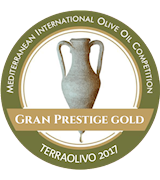
Terraolivo IOOC - Gran Prestige Gold
2017, 2015
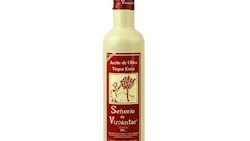

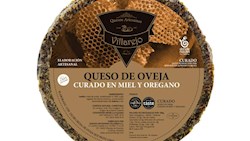

TasteAtlas food rankings are based on the ratings of the TasteAtlas audience, with a series of mechanisms that recognize real users and that ignore bot, nationalist or local patriotic ratings, and give additional value to the ratings of users that the system recognizes as knowledgeable. For the “Top 100 Spanish Foods” list until March 27, 2025, 21,738 ratings were recorded, of which 17,316 were recognized by the system as legitimate. TasteAtlas Rankings should not be seen as the final global conclusion about food. Their purpose is to promote excellent local foods, instill pride in traditional dishes, and arouse curiosity about dishes you haven’t tried.
